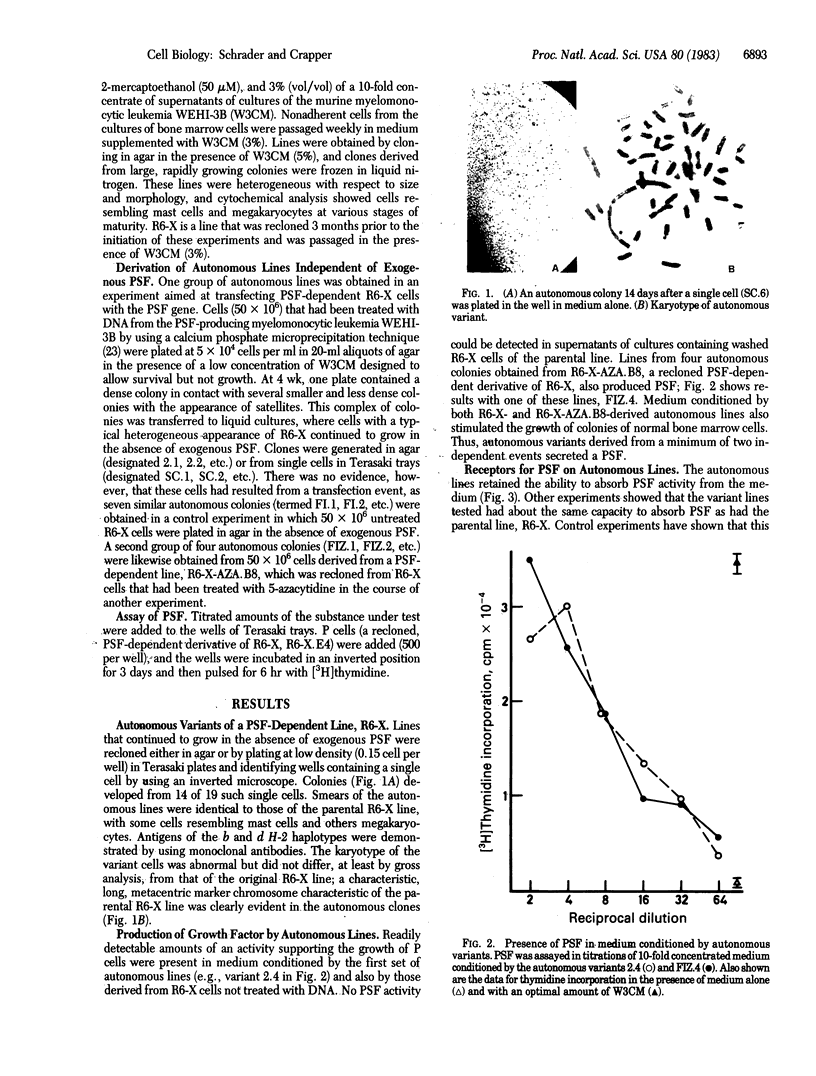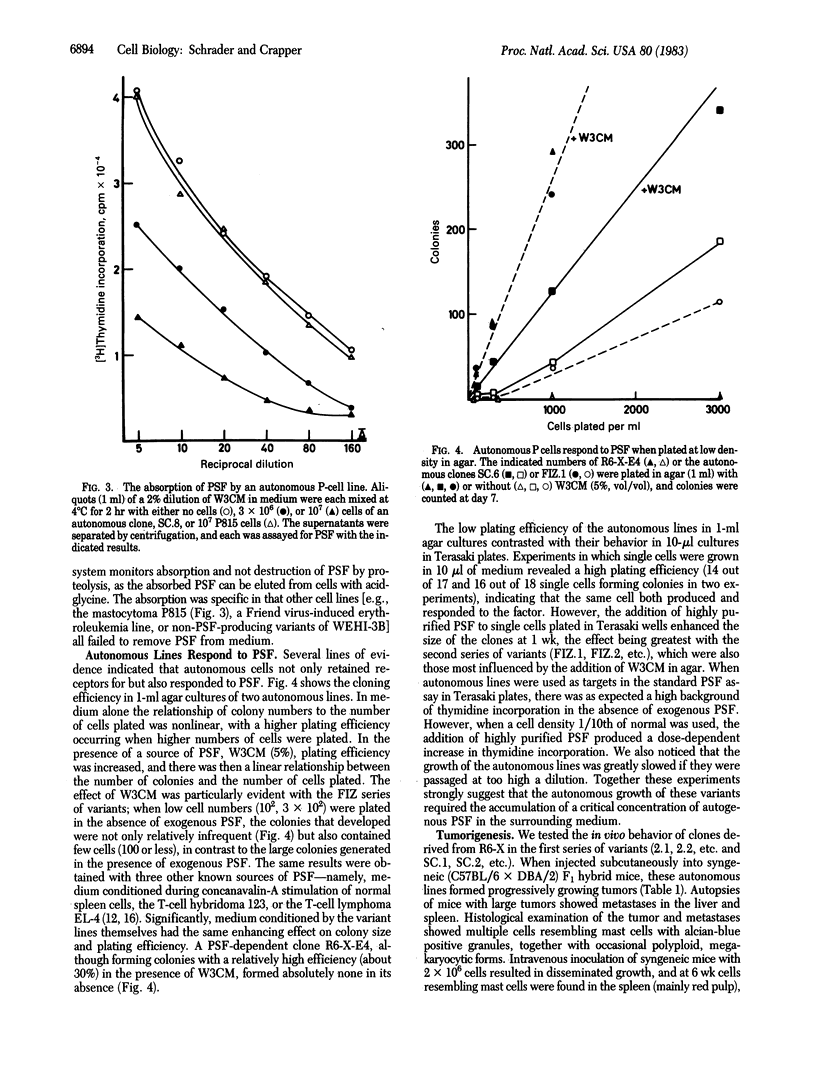Abstract
Lines of hemopoietic progenitor cells can be grown for prolonged or indefinite periods in vitro in the presence of a specific growth factor produced by activated T lymphocytes, persisting (P)-cell-stimulating factor (PSF). From such a PSF-dependent line, we report the emergence of variants that had concomitantly acquired both the capacity for autonomous growth in the absence of exogenous PSF and the capacity for the autogenous production of PSF. The link between these two new properties was strengthened by the demonstration that the variant lines absorbed PSF and, in some culture conditions, responded to exogenous PSF. Thus when variant cells were plated at low density in 1-ml agar cultures, cloning efficiency and colony size were enhanced by supplementation with sources of PSF, including medium conditioned by concanavalin A-stimulated normal spleen cells, T-cell tumors and T-cell hybridomas, and, importantly, medium conditioned by the autonomous P-cell lines themselves. In contrast to the parental line, the autonomous clones tested formed progressively growing tumors in vivo. It is proposed that the myelomonocytic leukemia WEHI-3B that produces PSF arose from a neutrophil-macrophage progenitor through acquisition of the capacity for the autogenous production of PSF and that the autogenous production of PSF may play a similar role in a range of proliferative disorders both of the blood and of other tissues containing components derived from the bone marrow.
Full text
PDF




Images in this article
Selected References
These references are in PubMed. This may not be the complete list of references from this article.
- Bazill G. W., Haynes M., Garland J., Dexter T. M. Characterization and partial purification of a haemopoietic cell growth factor in WEHI-3 cell conditioned medium. Biochem J. 1983 Mar 15;210(3):747–759. doi: 10.1042/bj2100747. [DOI] [PMC free article] [PubMed] [Google Scholar]
- Clark-Lewis I., Schrader J. W. P cell-stimulating factor: biochemical characterization of a new T cell-derived factor. J Immunol. 1981 Nov;127(5):1941–1947. [PubMed] [Google Scholar]
- Crapper R. M., Schrader J. W. Frequency of mast cell precursors in normal tissues determined by an in vitro assay: antigen induces parallel increases in the frequency of P cell precursors and mast cells. J Immunol. 1983 Aug;131(2):923–928. [PubMed] [Google Scholar]
- Dexter T. M., Garland J., Scott D., Scolnick E., Metcalf D. Growth of factor-dependent hemopoietic precursor cell lines. J Exp Med. 1980 Oct 1;152(4):1036–1047. doi: 10.1084/jem.152.4.1036. [DOI] [PMC free article] [PubMed] [Google Scholar]
- Doolittle R. F., Hunkapiller M. W., Hood L. E., Devare S. G., Robbins K. C., Aaronson S. A., Antoniades H. N. Simian sarcoma virus onc gene, v-sis, is derived from the gene (or genes) encoding a platelet-derived growth factor. Science. 1983 Jul 15;221(4607):275–277. doi: 10.1126/science.6304883. [DOI] [PubMed] [Google Scholar]
- Gootenberg J. E., Ruscetti F. W., Mier J. W., Gazdar A., Gallo R. C. Human cutaneous T cell lymphoma and leukemia cell lines produce and respond to T cell growth factor. J Exp Med. 1981 Nov 1;154(5):1403–1418. doi: 10.1084/jem.154.5.1403. [DOI] [PMC free article] [PubMed] [Google Scholar]
- Greenberger J. S., Sakakeeny M. A., Humphries R. K., Eaves C. J., Eckner R. J. Demonstration of permanent factor-dependent multipotential (erythroid/neutrophil/basophil) hematopoietic progenitor cell lines. Proc Natl Acad Sci U S A. 1983 May;80(10):2931–2935. doi: 10.1073/pnas.80.10.2931. [DOI] [PMC free article] [PubMed] [Google Scholar]
- HSU T. C. Chromosomal evolution in cell populations. Int Rev Cytol. 1961;12:69–161. doi: 10.1016/s0074-7696(08)60539-2. [DOI] [PubMed] [Google Scholar]
- Harrison D. E., Astle C. M., Delaittre J. A. Loss of proliferative capacity in immunohemopoietic stem cells caused by serial transplantation rather than aging. J Exp Med. 1978 May 1;147(5):1526–1531. doi: 10.1084/jem.147.5.1526. [DOI] [PMC free article] [PubMed] [Google Scholar]
- Holley R. W. Control of growth of mammalian cells in cell culture. Nature. 1975 Dec 11;258(5535):487–490. doi: 10.1038/258487a0. [DOI] [PubMed] [Google Scholar]
- Ihle J. N., Keller J., Oroszlan S., Henderson L. E., Copeland T. D., Fitch F., Prystowsky M. B., Goldwasser E., Schrader J. W., Palaszynski E. Biologic properties of homogeneous interleukin 3. I. Demonstration of WEHI-3 growth factor activity, mast cell growth factor activity, p cell-stimulating factor activity, colony-stimulating factor activity, and histamine-producing cell-stimulating factor activity. J Immunol. 1983 Jul;131(1):282–287. [PubMed] [Google Scholar]
- Iscove N. N., Roitsch C. A., Williams N., Guilbert L. J. Molecules stimulating early red cell, granulocyte, macrophage, and megakaryocyte precursors in culture: similarity in size, hydrophobicity, and charge. J Cell Physiol Suppl. 1982;1:65–78. doi: 10.1002/jcp.1041130412. [DOI] [PubMed] [Google Scholar]
- McCulloch E. A., Izaguirre C. A., Chang L. J., Smith L. J. Renewal and determination in leukemic blast populations. J Cell Physiol Suppl. 1982;1:103–111. doi: 10.1002/jcp.1041130417. [DOI] [PubMed] [Google Scholar]
- Metcalf D. Humoral regulators in the development and progression of leukemia. Adv Cancer Res. 1971;14:181–230. doi: 10.1016/s0065-230x(08)60521-7. [DOI] [PubMed] [Google Scholar]
- Metcalf D., Moore M. A., Warner N. L. Colony formation in vitro by myelomonocytic leukemic cells. J Natl Cancer Inst. 1969 Oct;43(4):983–1001. [PubMed] [Google Scholar]
- Rice D., Baltimore D. Regulated expression of an immunoglobulin kappa gene introduced into a mouse lymphoid cell line. Proc Natl Acad Sci U S A. 1982 Dec;79(24):7862–7865. doi: 10.1073/pnas.79.24.7862. [DOI] [PMC free article] [PubMed] [Google Scholar]
- Roberts A. B., Lamb L. C., Newton D. L., Sporn M. B., De Larco J. E., Todaro G. J. Transforming growth factors: isolation of polypeptides from virally and chemically transformed cells by acid/ethanol extraction. Proc Natl Acad Sci U S A. 1980 Jun;77(6):3494–3498. doi: 10.1073/pnas.77.6.3494. [DOI] [PMC free article] [PubMed] [Google Scholar]
- Ross E. A., Anderson N., Micklem H. S. Serial depletion and regeneration of the murine hematopoietic system. Implications for hematopoietic organization and the study of cellular aging. J Exp Med. 1982 Feb 1;155(2):432–444. doi: 10.1084/jem.155.2.432. [DOI] [PMC free article] [PubMed] [Google Scholar]
- Schrader J. W., Battye F., Scollay R. Expression of Thy-1 antigen is not limited to T cells in cultures of mouse hemopoietic cells. Proc Natl Acad Sci U S A. 1982 Jul;79(13):4161–4165. doi: 10.1073/pnas.79.13.4161. [DOI] [PMC free article] [PubMed] [Google Scholar]
- Schrader J. W. In in vitro production and cloning of the P cell, a bone marrow-derived null cell that expresses H-2 and Ia-antigens, has mast cell-like granules, and is regulated by a factor released by activated T cells. J Immunol. 1981 Feb;126(2):452–458. [PubMed] [Google Scholar]
- Schrader J. W., Lewis S. J., Clark-Lewis I., Culvenor J. G. The persisting (P) cell: histamine content, regulation by a T cell-derived factor, origin from a bone marrow precursor, and relationship to mast cells. Proc Natl Acad Sci U S A. 1981 Jan;78(1):323–327. doi: 10.1073/pnas.78.1.323. [DOI] [PMC free article] [PubMed] [Google Scholar]
- Schrader J. W., Nossal G. J. Strategies for the analysis of accessory-cell function: the in vitro cloning and characterization of the P cell. Immunol Rev. 1980;53:61–85. doi: 10.1111/j.1600-065x.1980.tb01040.x. [DOI] [PubMed] [Google Scholar]
- Walker E. B., Lanier L. L., Warner N. L. Characterization and functional properties of tumor cell lines in accessory cell replacement assays. J Immunol. 1982 Feb;128(2):852–859. [PubMed] [Google Scholar]
- Waterfield M. D., Scrace G. T., Whittle N., Stroobant P., Johnsson A., Wasteson A., Westermark B., Heldin C. H., Huang J. S., Deuel T. F. Platelet-derived growth factor is structurally related to the putative transforming protein p28sis of simian sarcoma virus. Nature. 1983 Jul 7;304(5921):35–39. doi: 10.1038/304035a0. [DOI] [PubMed] [Google Scholar]
- Yung Y. P., Eger R., Tertian G., Moore M. A. Long-term in vitro culture of murine mast cells. II. Purification of a mast cell growth factor and its dissociation from TCGF. J Immunol. 1981 Aug;127(2):794–799. [PubMed] [Google Scholar]
- de Larco J. E., Todaro G. J. Growth factors from murine sarcoma virus-transformed cells. Proc Natl Acad Sci U S A. 1978 Aug;75(8):4001–4005. doi: 10.1073/pnas.75.8.4001. [DOI] [PMC free article] [PubMed] [Google Scholar]



